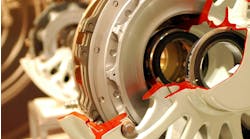Hydraulic presses are usually rated by the amount of force they can apply. Force is required to form the work pieces, but so is energy. One important part of press control is controlling the force that is required to form a part, and this means controlling the energy also.
There can be two extremes for forming parts. In one extreme, the press closes on the part and makes contact at near 0 speed, then builds pressure/force until the part is formed. This works, but time and energy are wasted; energy is wasted slowing down the press to near zero speed, and time is wasted because it takes time to build force in the cylinder(s).
The other extreme is to use kinetic energy to form the parts. Since takes the integral of force times distance to form the part, this can be easily accomplished by matching the amount of kinetic energy to the amount of work required. Matching the kinetic energy to the work that needs to be done doesn’t waste energy slowing down to near stop, and it doesn’t waste time because there is no need to build up force to form the part.
Ideally matching the kinetic energy to the amount of work that needs to be done would be the best way to form parts. However, matching the kinetic energy to the work needed is difficult because the amount of kinetic energy an object has is a function of the velocity squared. This means there must be precise velocity control at impact. For optimum throughput, it is best if the press platen/slider comes down quickly, then decelerates to the precise speed that will result in the right amount of kinetic energy being delivered.
There are a few difficulties with this. First, presses expand due to thermal expansion so the exact position of contact will change during the day. This means that having the exact speed and the position of impact will vary. The press controls need to be adaptive by changing the deceleration position. This way, the impact velocity will be correct at impact even if the position changes a bit.
Another constraint is the deceleration rate. Since most presses have the cylinder rod pointing down, there is much more area on the top of the piston than on the bottom, so it is easy for the cylinder to cavitate while decelerating. Some presses have fill valves that allow oil to be “sucked out” of an oil tank at atmospheric pressure into the cap side to solve this problem.
A common question is, “Do I need to re-tune the controller when the parts change?” The answer is generally no. It isn’t the press that is changing, it is the amount of energy required to form the workpiece or the position of impact. Generally, the amount of energy required to form a type of part is pretty much the same from part to part, so once the correct impact speed is determined for a given part, the impact speed should be recorded so the next time the part is being made the correct impact speed can be set up quickly. The hydraulic controller should not need to be tuned.
Another constraint is the response time of the servo valves controlling the press cylinders. Hydraulic servo valves are fast, but not faster than the potential force spike. A high-speed impact may be over in a few milliseconds which is faster than most hydraulic servo valves can respond to even if the sensors and controller are fast enough. If the workpiece is not very compliant then the rate of change in force can be too fast for the servo valve to respond and control. Therefore, the impact speed must be reduced to match the required work that must be done. Even so, the servo valve will still be open so it will add still more energy in the form of hydraulic pressure to the system. So in reality, kinetic energy can be used for most of the required energy for forming the workpiece, but hydraulic pressure is still required for the fine adjustment or control.
One addition to a press that would make it easier to control is to add a cushion. Mechanical presses often have hydraulic cushions, but a hydraulic press should be able to use a hard rubber mat for a cushion. The idea is that both the workpieces and the mat will absorb some of the energy of the press. While the press must move a little farther to compress both the workpiece and the mat, the valve has more time to respond. This permits better control and consistency at the expense of a bit of wasted energy that goes into the hard rubber mat.
In short, press control is not simple. There are a few things like pressure, impact speed and cushions that have their advantages and disadvantages, depending on the trade-offs one is willing to make.
Peter Nachtwey is president of Delta Computer Systems, Inc.

